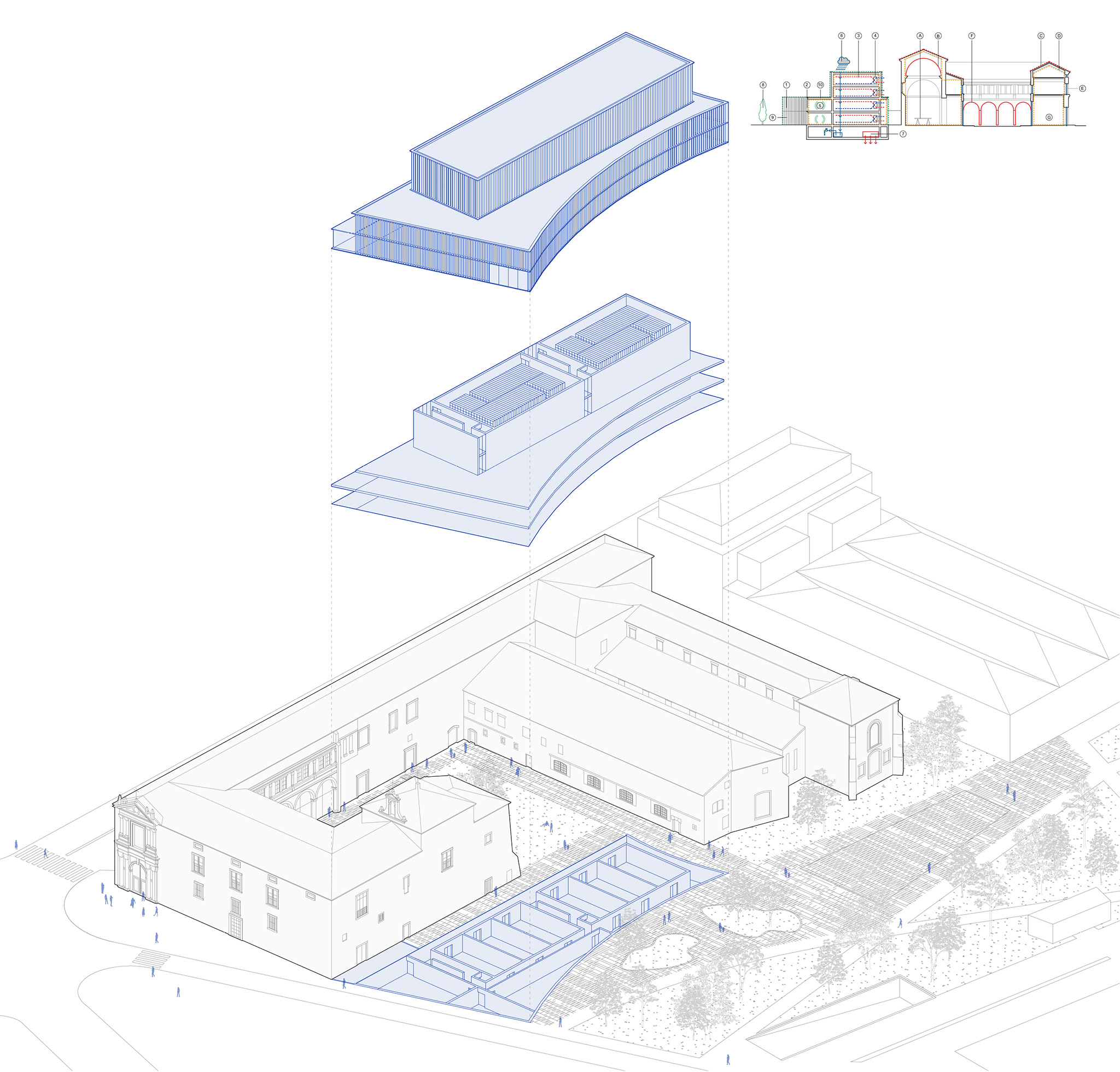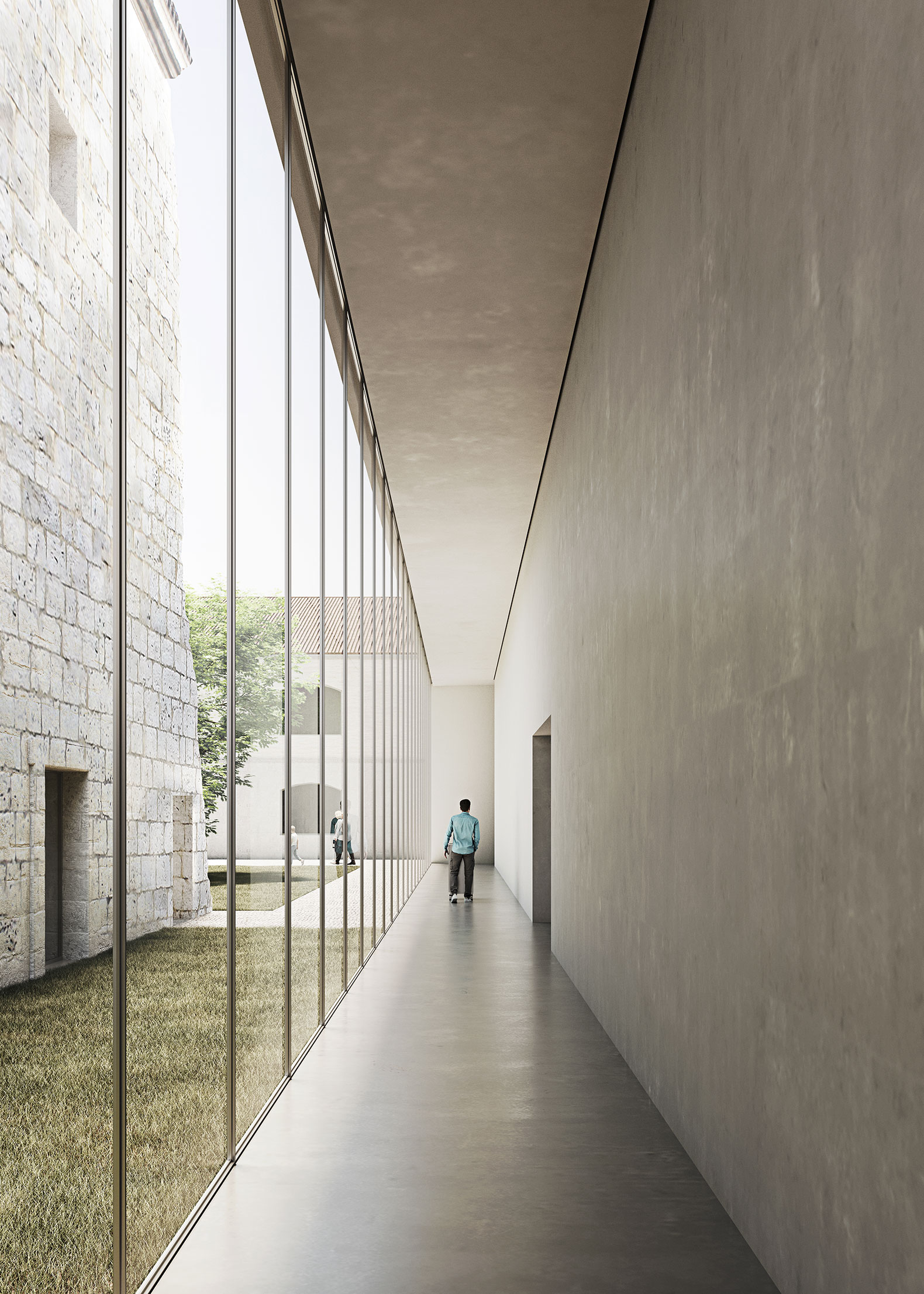The proposal reflects the construction of a new volume in the complex. This will house the central uses of the archive: classification areas, entrance, storage and workshops. The jury valued the aesthetics and design for its ease of maintenance, durability in terms of materials, energy efficiency and constructive simplicity.
Visually, the new building volume stands out for its façade made of local stone from the Hontoria area, but with a lightness thanks to its lightened system of vertical ribs. This structure allows for thermal control by adjusting the solar incidence.
The pre-existing historic building will be used to house the university programme. It is proposed with distribution by cores that divide the different users and their routes, new accesses are also established to improve their connection. The use of large windows and galleries allows the permeability of the interior spaces, as well as highlighting distinctive elements of the old building. It is a decision that establishes a high visual and perceptive quality of the site.

Axonometry. Provincial Historical Archive of Burgos by ABLM Arquitectos + ATELIER 62.
Description of project by ABLM Arquitectos + ATELIER 62
The proposal proposes the recovery of the Hospital de la Concepción in Burgos (16th-17th century) as an urban cultural centre. In addition to housing the Provincial Historical Archive of Burgos, it offers a non-exclusive infrastructure for the users of the archive and the University of Burgos, this being a project for all citizens.
Creating a city and public space are fundamental conditioning factors of the strategy presented. The Hospital de la Concepción and the new Archive will become a new urban, social, educational and cultural enclave, open to the city of Burgos and its visitors.
We are rescuing from urban oblivion an infrastructure with great historical weight in the Castilian city and an exquisite heritage in its foundations. We propose the complex as a citizens' route, proposing a space linked to education and culture whose versatility can be adapted to the needs of the city.
We propose a reorganisation of the interior spaces of the Hospital for the location of the uses required by the programme, both proposed by the Ministry of Culture (Archive) and by the University of Burgos. We propose a distribution of spaces that enhances and adds value to the architectural heritage. A building open to the city, whose organisation will be carried out through a series of open spaces, which will facilitate the dialogue between the exterior and the interior.
A new building is proposed as an extension of the archive, articulating it with the old hospital. This piece seeks at all times to enhance the historic building and revitalise it at the same time, avoiding any kind of conflict that would adulterate it. To this end, a two-level plinth is provided with a slightly curved façade line and the upper floors are set back, lightening the general volumetry by using light vertical elements built with Hontoria stone that fragments it and makes it less massive. This new building will house most of the archives, understanding it as a contemporary archive that is inserted in society, becoming a space of knowledge. It is configured with a floor whose heart are the spaces destined for storage and around which the life of the archive workers develops, making this a dynamic building facing the city.
The future users of the University of Burgos and the new Provincial Archive will be participants in the new cultural spaces offered in this proposal. The management of these spaces will be carried out in parallel to the daily activity of the workers and the deposits, guaranteeing the correct functioning of the whole. We prioritise a distribution based on open areas that can be transformed. Finally, we achieved a correct functioning of the whole building offering an ideal working comfort without causing any kind of interference between uses due to the clear independence of routes between the UBU building, the new users of the archive and the storage areas.
The programme of needs of the archive is organised by areas with different degrees of privacy, as follows:
-Restricted access area. Formed by work areas and storage deposits.
-Controlled access area. Where the centre's own administration is located
-Public access area. Used by a wide range of users, researchers, students, casual visitors, those attending the cultural programme...

Rendering. Provincial Historical Archive of Burgos by ABLM Arquitectos + ATELIER 62.
New building
This new volume will house the most characteristic uses of an archive, admission and classification areas, workshops and storage areas. Its access is on Calle Barrio Gimeno, on the corner where the historic building ends.
Historical Building
Bearing in mind that the original 16th-century building will be used for university purposes, the archive will be developed in the 17th century extension, with access on the corner of Calle Barrio Gimeno.
Due to the need to cover a large demand for square metres of archives, public, controlled and restricted uses will coexist in this building. Three new vertical cores are planned to respect the three circulation circuits of the different areas. On the one hand, a vertical nucleus with restricted access is planned in the building perpendicular to Calle Madrid, in this same building another nucleus is planned, this time with controlled access for administration users, the nuclei are arranged in such a way that in no case do the circulations cross. The last of the proposed nuclei is located in the building parallel to Calle Madrid, this nucleus connects the public space with a series of so-called shared uses.
In the new building, a façade of stone from Hontoria (Burgos) is proposed with a lightened system based on the repetition of vertical ribs. This strategy makes it possible to control the incidence of sunlight on the west façade of the new building, favouring interior comfort. The repetition of these elements activates the image of the building by conceiving a façade of interest within the urban fabric.
These ribs will be made up of dry-assembled stone blocks, supported by steel brackets which in turn will be mechanically fixed to the concrete load-bearing structure. The same stone used to build the historic building will be used, thus achieving the correct relationship between the traditional and the contemporary, but seeking a lighter and fluffier layout.
Different strategies have been developed to guarantee the correct passive functioning of the building, ensuring the necessary environmental conditions for the proper conservation of the documentation with the minimum dependence on energy and installations.
Taking into account the geographical conditions of this infrastructure, as well as the solar incidence on the façades, a building is designed that will follow passivhaus criteria in its definition. A continuous thermal envelope is planned with high-performance carpentry and control of possible thermal bridges. The building will be constructed with the insulation thicknesses defined according to the calculation of the PassivhausInstitut's PHPP tool.











































